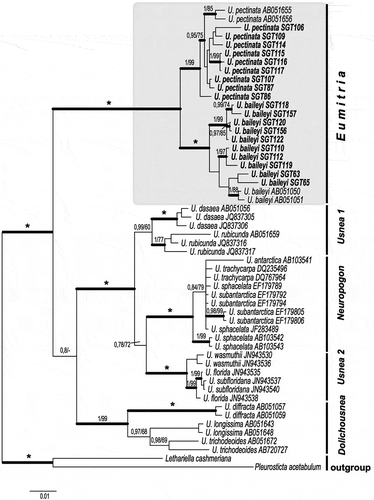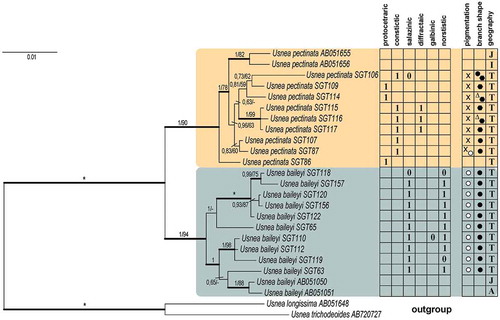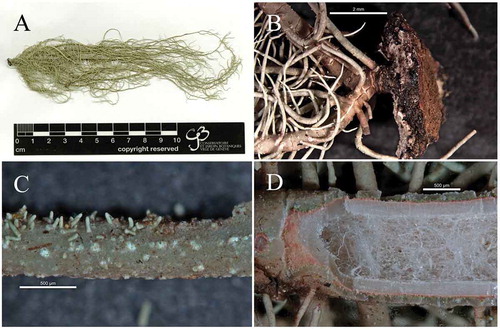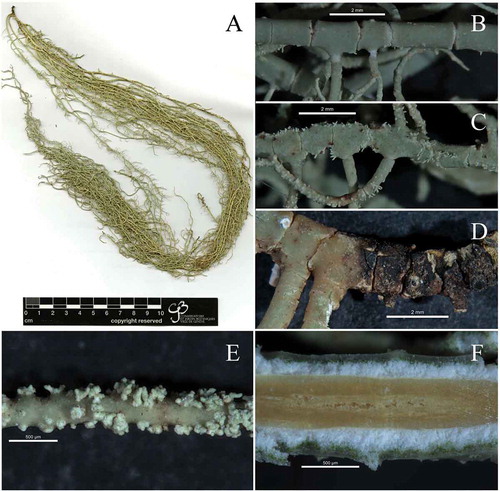Figures & data
Table 1. Table of Usnea subgenus Eumitria taxa from Africa (Dodge Citation1956; Swinscow and Krog Citation1974, Citation1986; Krog Citation1994) with their main chemistry indicated by X; protocetraric acid (PRO), fumarprotocetraic acid (FUM), diffractaic acid (DIF), salazinic acid (SAL), norstictic acid (NOR), constictic acid (CON), thamnolic acid (THA), psoromic acid (PSO), triterpenoids (TRI), virensic acid (VIR).
Table 2. Species and GenBank accession numbers of sequences used in the DNA analyses. Newly produced sequences in bold.
Figure 2. Consensus tree based on a Bayesian and ML analyses of concatenated ITS, nuLSU, RPB1 and MCM7 showing infrageneric clades in Usnea. The tree was rooted using two species Pleurosticta acetabulum and Lethariella cashmeriana. The two support values associated with each internal branch correspond to posterior probability (PP) and bootstrap support (bs) respectively. Branches in bold indicate a support of PP ≥ 95% and a MLbs ≥ 70%. An asterisk on a bold branch indicates that this node has a support of 100 % for both support estimates. A dash instead of a MLbs value indicates that the node of the Bayesian tree was not recovered by ML bootstrapping. Species groups (within annotation marks) are in accordance with Truong et al (Citation2013). Eumitria is highlighted by a shaded box.

Figure 3. Consensus tree based on Bayesian and ML analyses of Eumitria species in Tanzania (ITS, nuLSU, RPB1 & MCM7). The two support values associated with each internal branch correspond to posterior probability (PP) and bootstrap support (bs) respectively. Branches in bold indicate a support of PP ≥ 95% and a MLbs ≥ 70%. An asterisk on a bold branch indicates that this node has a support of 100% for both support estimates. A dash instead of a MLbs value indicates that the node of the Bayesian tree was not recovered by ML bootstrapping. A: America, I: Indonesia, J: Japan, T: Tanzania 1: main chemical substance, 0 accessory chemical substance, x: dark brown pigmentation, big black dots: terete branch shape, triangles: alate branch shape, pentagon: ridged branch shape.

Figure 4. Usnea baileyi; (a): Usnea baileyi studied specimen (SGT 157), (b): blackish base, (c): soralia with short isidiomorphs (d): thin and shiny cortex, red subcortical pigment and tubular axis filled with loose hyphae.

Figure 5. Usnea pectinata; (a): Usnea pectinata studied specimen (SGT 114), (b): smain branch cylindrical with terete segments, (c): main branch irregular with alate segments, (d): blackish base, (e): soralia with short isidiomorphs, (e): dark brown pigmented axis of main branch with some fistulose areas in the central part of the axis.

Table 3. Comparison of U. baileyi anatomical characters. Mean (italic), standard deviation and extreme values (in parenthesis) are shown.

